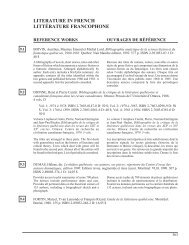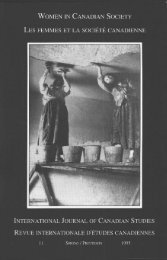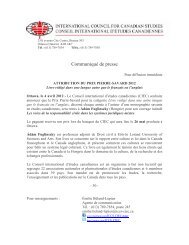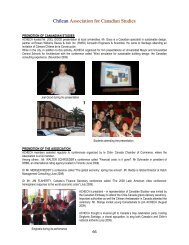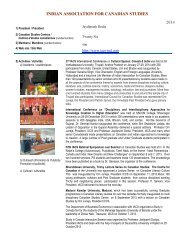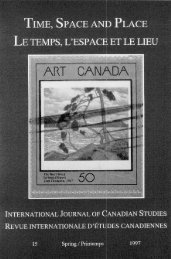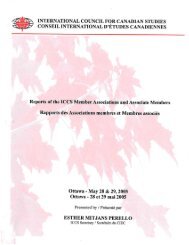Arts and Literature in Canada:Views from Abroad, Les arts et la ...
Arts and Literature in Canada:Views from Abroad, Les arts et la ...
Arts and Literature in Canada:Views from Abroad, Les arts et la ...
- No tags were found...
You also want an ePaper? Increase the reach of your titles
YUMPU automatically turns print PDFs into web optimized ePapers that Google loves.
IJCS/RIÉCmoment of harmony <strong>and</strong> contentment with her daughter <strong>and</strong> her husb<strong>and</strong> ismean<strong>in</strong>gful. However pa<strong>in</strong>ful <strong>and</strong> guiltridden her personal memories may be,life will flow on <strong>in</strong>to an open future.In both Lives of Girls <strong>and</strong> Women <strong>and</strong> K<strong>in</strong>dheitsmuster, the importance of theriver as a carrier of mean<strong>in</strong>g, is not merely <strong>in</strong>cidental. It reveals an<strong>in</strong>terpr<strong>et</strong>ation of what <strong>in</strong>itially seemed a freakish co<strong>in</strong>cidence, the astound<strong>in</strong>gfact that two totally unre<strong>la</strong>ted writers should choose the same family name,Jordan, for their family histories. We may assume that both Alice Munro <strong>and</strong>Christa Wolf have chosen the biblical name of the arch<strong>et</strong>ypal river as acomplex textual sign. Whereas the primary mean<strong>in</strong>g of Jordan refers to theBible as the <strong>in</strong>tertext l<strong>in</strong>k<strong>in</strong>g the two novels, the secondary, “secu<strong>la</strong>rized” useof Jordan as a family name evokes a symbol of coherence <strong>and</strong> cont<strong>in</strong>uity <strong>in</strong><strong>in</strong>dividual lives as well as <strong>in</strong> family traditions. The religious connotation <strong>in</strong>Munro’s “Baptiz<strong>in</strong>g” episode is obvious. Del’s immersion <strong>in</strong> the river reflectsher refusal of be<strong>in</strong>g forced <strong>in</strong>to a religious rite that might b<strong>in</strong>d her forever. Hersurfac<strong>in</strong>g signals a form of rebirth that restores her personal autonomy <strong>and</strong><strong>in</strong>tegrity.In K<strong>in</strong>dheitsmuster, the symbol “river” seems to carry a less obvious, butnon<strong>et</strong>heless significant religious mean<strong>in</strong>g. We may <strong>in</strong>terpr<strong>et</strong> the central “riverepisode” as a cross<strong>in</strong>g <strong>from</strong> guilt to <strong>in</strong>nocence. (As shown <strong>in</strong> previousquotations, both “cross<strong>in</strong>g” <strong>and</strong> “<strong>in</strong>nocence” have been anticipated.) This<strong>in</strong>terpr<strong>et</strong>ation appears confirmed by Nelly’ experience of spirituality, reflected<strong>in</strong> her state of <strong>in</strong>expressible contentment <strong>and</strong> harmony. If we consider Nelly’sjourney <strong>in</strong>to the past as a whole, this sensation of compl<strong>et</strong>eness, of a harmonyof body <strong>and</strong> soul, has brought her nearer to her professed aim, “to escape themortal s<strong>in</strong> of our time: the desire not to come to grips with oneself” (MC 406).For a theor<strong>et</strong>ical ground<strong>in</strong>g of an <strong>in</strong>terpr<strong>et</strong>ation that sees Jordan as a symbol ofcoherence <strong>and</strong> cont<strong>in</strong>uity <strong>in</strong> family histories, Hans Robert Jauß’ critica<strong>la</strong>pproach may provide an adequate m<strong>et</strong>hod. Whereas traditional literarycriticism used to assess a text’s <strong>in</strong>herent timeless values, Jauß’ negates thevalidity of fixed canons. His concept of “Horizontw<strong>and</strong>el” 3l sees the presentreader/critic <strong>in</strong>volved <strong>in</strong> a cont<strong>in</strong>uous dialogue b<strong>et</strong>ween past <strong>and</strong> present. Any<strong>in</strong>terpr<strong>et</strong>ation of a text (be it po<strong>et</strong>ic or non literary) will depend on thehistorically <strong>and</strong> culturally d<strong>et</strong>erm<strong>in</strong>ed code of the respective reader’s/critic’shere <strong>and</strong> now. Arguably, the present day reader’s response to Lives of Girls<strong>and</strong> Women <strong>and</strong> K<strong>in</strong>dheitsmuster, some twenty years after their firstappearance, may well disregard some of their historical or topographicalimplications <strong>and</strong> value them as exemp<strong>la</strong>ry childhood memories embedded <strong>in</strong>family histories. The arch<strong>et</strong>ypal river <strong>and</strong> its reverberation <strong>in</strong> the family namesof the two protagonists, Del Jordan <strong>and</strong> Nelly Jordan, suggests <strong>in</strong>deed aparabolic dimension. In that sense, K<strong>in</strong>dheitsmuster <strong>and</strong> Lives of Girls <strong>and</strong>Women may be seen as parables of universal experience. The titles po<strong>in</strong>t <strong>in</strong> thesame direction: “K<strong>in</strong>dheitsmuster” suggests a pattern, dem<strong>and</strong><strong>in</strong>g to be reperformed <strong>in</strong> the reader’s imag<strong>in</strong>ation; “lives of girls <strong>and</strong> women,” a three fold82



